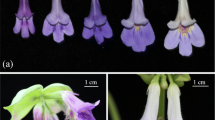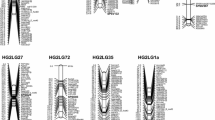Abstract
Polymorphism of SLG (the S-locus glycoprotein gene) in Brassica campestris was analyzed by PCR-RFLP using SLG-specific primers. Nucleotide sequences of PCR products from 15 S genotypes were determined in order to characterise the exact DNA fragment sizes detected in the PCR-RFLP analysis. Forty-seven lines homozygous for 27 S-alleles were used as plant material. One combination of primers, PS5 + PS 15, which had a nucleotide sequence specific to a class-I SLG, gave amplification of a single DNA fragment of approximately 1.3kb from the genomic DNA of 15 S genotypes. All the DNA fragments showed different electrophroetic profiles from each other after digestion with MboI or MspI. Different lines having the same S genotype had an identical electrophoretic profile even between the lines collected in Turkey and in Japan. Another class-I SLG-specific primer, PS 18, gave amplification of a 1.3-kb DNA fragment from three other S genotypes in combination with PS 15, and the PCR product also showed polymorphism after cleavage with the restriction endonucleases. Genetic analysis, Southern-hybridization analysis, and determination of the nucleotide sequences of the PCR products suggested that the DNA fragments amplified with these combinations of primers are class-I SLGs. Expected DNA fragment sizes in the present PCR-RFLP condition were calculated from the determined nucleotide sequence of SLG PCR products. A single DNA fragment was also amplified from six S genotypes by PCR with a combination of primers, PS3 + PS21, having a nucleotide sequence specific to a class-II SLG. The amplified DNA showed polymorphisnm after cleavage with restriction endonucleases. The cleaved fragments were detected by Southern-hybridization analysis using a probe of S 5 SLG cDNA, a class-IISLG. Partial sequencing revealed a marked similarity of these amplified DNA fragments to a class-II SLG, demonstrating the presence of class-I and class-II S alleles also in B. campestris. The high SLG polymorphism detected by the present investigation suggests the usefulness of the PCR-RFLP method for the identification of S alleles in breeding lines and for listing S alleles in B. campestris.
Similar content being viewed by others
References
Boyes DC, Chen CH, Tantikanjana T, Esch JJ, Nasrallah JB (1991) Isolation of a second S-locus-related cDNA from Brassica oleracea: genetic relationships between the S locus and two related loci. Genetics 127:221–228
Brace J, Ockendon DJ, King GJ (1993) Development of a method for the identification of S alleles in Brassica oleracea based on digestion of PCR-amplified DNA with restriction endonucleases. Sex Plant Reprod 6:133–138
Brace J, King GJ, Ockendon DJ (1994) A molecular approach to the identification of S-alleles in Brassica oleracea. Sex plant Reprod 7:203–208
Chen CH, Nasrallah JB (1990) A new class of S sequences defined by a pollen recessive self-incompatibility allele of Brassica oleracea. Mol Gen Genet 222:241–248
Dwyer KG, Balent MA, Nasrallah JB, Nasrallah ME (1991) DNA sequences of self-incompatibility genes from Brassica campestris and B. oleracea: polymorphism predating speciation. Plant Mol Biol 16:481–486
Goring DR, Rothstein SJ (1992) The S-locus receptor kinase gene in a self-incompatible Brassica napus line encodes a functional serine/threonine kinase. Plant Cell 4:1273–1281
Hinata K, Nishio T (1981) Con A-peroxidase method: an improved procedure for staining S-glycoproteins in cellulose-acetate electrofocusing in Crucifers. Theor Appl Genet 60:281–283
Lalonde BA, Nasrallah ME, Dwyer KG, Chen CH, Barlow B, Nasrallah JB (1989) A high conserved Brassica gene with homology to the S-locus-specific glycoprotein structural gene. Plant Cell 1:249–258
Nasrallah JB, Kao TH, Goldberg ML, Nasrallah ME (1985) A cDNA clone encoding an S-locus-specific glycoprotein from Brassica oleracea. Nature 318:263–267
Nasrallah JB, Kao TH, Chen CH, Goldberg ML, Nasrallah ME (1987) Amino-acid sequence of glycoproteins encoded by three alleles of the S locus of Brassica oleracea. Nature 326:617–619
Nasrallah JB, Yu SM, Nasrallah ME (1988) The self-incompatibility genes of Brassica oleracea: expression, isolation and structure. Proc Natl Acad Sci USA 85:5551–5555
Nishio T, Hinata K (1982) Comparative studies on S-glycoproteins purified from different S-genotypes in self-incompatible Brassica species. I. Purification and chemical properties. Genetics 100:641–647
Nishio T, Sakamoto K (1993) PCR-RFLP of S-locus for the identification of breeding lines in Brassica. Jpn J Breed (Suppl 1): 274
Nishio T, Sakamoto K, Yamaguchi J (1994) PCR-RFLP of S locus for identification of breeding lines in cruciferous vegetables. Plant Cell Rep 13:546–550
Nou IS, Watanabe M, Isogai A, Hinata K (1993) Comparison of S-alleles and S-glycoproteins between two wild populations of Brassica campestris in Turkey and Japan. Sex Plant Reprod 6:79–86
Ockendon DJ (1974) Distribution of self-incompatibility alleles and breeding structure of open-pollinated cultivars of Brussel sprouts. Heredity 33:159–171
Rogers SO, Bendich AJ (1985) Extraction of DNA from milligram amounts of fresh, herbarium and mummified plant tissues. Plant Mol Biol 5:69–76
Stein JC, Howlett B, Boyes DC, Nasrallah ME, Nasrallah JB (1991) Molecular cloning of a putative receptor protein kinase gene encoded at the self-incompatibility locus of Brassica oleracea. Proc Natl Acad Sci USA 88:8816–8820
Trick M, Flavell RB (1989) A homozygous S genotype of Brassica oleracea expresses two S-like genes. Mol Gen Genet 218:112–117
Watanabe M, Takasaki T, Toriyama K, Yamakawa S, Isogai A, Suzuki A, Hinata K (1994) A high degree of homology exists between the protein encoded by SLG and the S receptor domain encoded by SRK in self-incompatible Brassica campestris L. Plant Cell Physiol 35:1221–1229
Yamakawa S, Shiba H, Watanabe M, Shiozawa H, Takayama S, Hinata K, Isogai A, Suzuki A (1994) The sequences of S-glycoproteins involved in self-incompatibility of Brassica campestris and their distribution among Brassicaceae. Biosci Biotech Biochem 58:921–925
Author information
Authors and Affiliations
Additional information
Communicated by G. Wenzel
Rights and permissions
About this article
Cite this article
Nishio, T., Kusaba, M., Watanabe, M. et al. Registration of S alleles in Brassica campestris L by the restriction fragment sizes of SLGs . Theoret. Appl. Genetics 92, 388–394 (1996). https://doi.org/10.1007/BF00223684
Received:
Accepted:
Issue Date:
DOI: https://doi.org/10.1007/BF00223684




